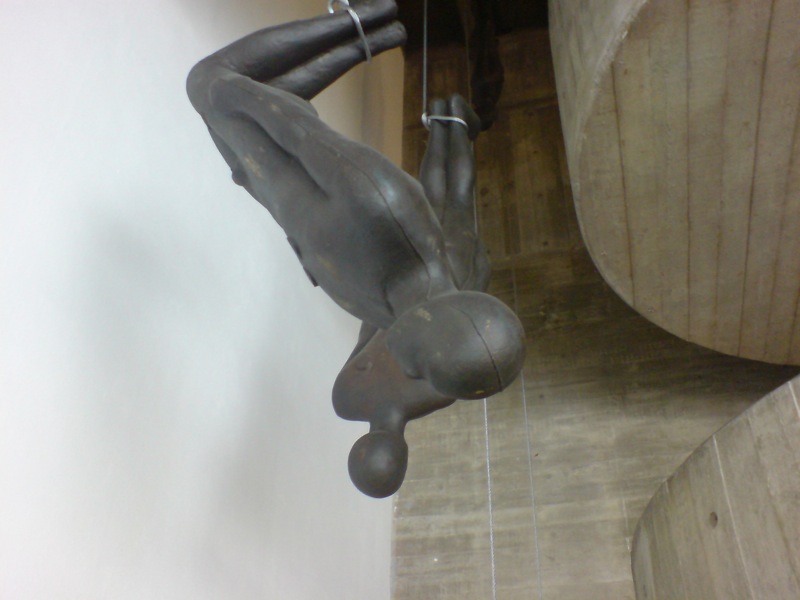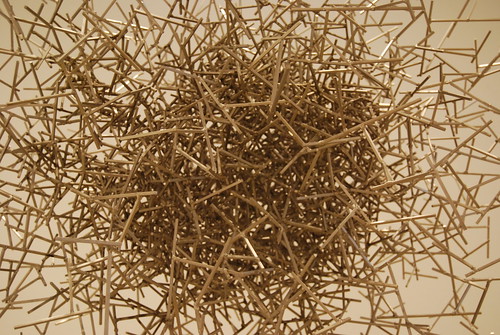I had been told what to expect: statues dotted around the skyline. I approached The Hayward, and saw one of them on the roof of a tall building. It was unnerving. He looked like he was about to jump. I was quite taken aback. Another city worker jumps to his death. But it was just a statue: he wasn't actually a he, and he wasn't going to jump, either.
And then I started spotting more. I headed up the stairs of the building, and completely missed the gallery entrance, but it made no difference, because I was spotting more and more statues. By the time I'd seen about four, all of which were looking at me, I was no longer worried that they were going to kill themselves: I was now feeling uneasy because I was worried they were actually going to kill me. Looking out into the distance, there were more. Snipers, no doubt. I felt very exposed. No no, they were just statues...
I found the gallery entrance, and was greeted with a sign I'd never seen before at an art exhibition: "Tickets are sold out. Due to the popularity of this exhibition, expect queues." It didn't make sense to me. I went in, and stumbled about the place a little before first realising where the box office was, and then where the queue for the box office actually ended. It didn't make much sense. I wasn't in a supermarket: I was in an art gallery: what was with the queue? I took out my little black book and scribbled some nonsense down to pass the time.
The sign had told the truth: there were no tickets left for that evening. After struggling with the concept of time a little, I finally worked out that I'd be able to return to the show on Sunday. I got my ticket. For Sunday, at 2pm.
Of course, 2pm was a terrible time to turn up on Sunday. I woke up on Sunday morning at about 6am, then spent the morning trying to think of things to do to make time pass more quickly. The weather was bleak, so hanging around outside wasn't appealing. Nonetheless, I ended up heading off to Waterloo and hanging around The Southbank for a bit, waiting for 2pm to arrive.
While there, I looked at the Coca-Cola bottle pop art that was on display. I wish I'd taken some notes, as I can't even remember what the exhibition was in aid of. There were some nice colours on display, though. Of course, the graffiti in the mini "skatepark" was far better. There are some amazing grafs down there: you should check them out. And I even saw some artists doing their thing. For the first time, I caught a whiff of the spraypaint they were using. It smelled like it would tear your lungs to pieces if you tried painting over any extended period of time. It's no wonder that some of the artists from the early 80s have a lot of health problems these days...
- - - - -
2pm finally came, and I wandered into the gallery for the main attraction of the day. The place was heaving. There was a monstruous construction called "Space Station" at the entrance. It was very impressive. But the queue for "Blind Light" was even more impressive. This queue must have been about 400m in length, and there was no way I was going to stand in it. "Blind Light" is a big fog-filled glass box. In Gormley's words: "It is very important for me that inside it you find the outside. Also you become the immersed figure in and endless ground, literally the subject of the work." It was a shame that I didn't get to experience the box, but I did enjoy looking at everyone wandering around, finding the walls. They looked like idiots. Thinking about it now, I should've asked them what it was like to be in there. Did they get the full effect, when it was absolutely full of people who had to pass through quickly? I thought about a book by Miguel de Unamuno, "Niebla" (Mist). I was tired, though, so my thoughts didn't get very far.

The gallery was packed: that much was true. Gormley had created an exhibition full of bodies, which in turn had attracted even more bodies. Wandering through "Allotment II" was a slightly stressful affair, akin to trying to get through a train station during peak times. In addition to the 300 life-size concrete boxes that served as abstract representations of actual people, there were at least 50 living, breathing human beings wandering around, knocking on the boxes, stroking the concrete, and discussing what they thought of it all. I personally didn't want to touch the statues, talk about them, or even look at them too closely: to me, they really were like people. I almost apologised when I bumped into one of them.
There was something very disturbing about the exhibition, and I wondered what the children there were thinking of it all. I came to "Critical Mass II": 5 cast iron statues suspended from the ceiling, as if they were being tortured. Very unsettling. The chair that was placed at the foot of the stairs, "where a guard or invigilator might sit" made it all even more unpleasant. The theme of torture continued with "Drawn", a room containing sculptures of the artist himself: "painfully forked caryatids cornered at different angles on the ceiling and the floor". In my tired state, I could sense the distress of the figures. Next door was another main attraction, but again, the queue was too long. I think it was another torture chamber. By now, I was very worn down by the number of people in the gallery. It almost felt like the whole gallery was a torture chamber.

However, I was glad for the company when it came to the final room of my tour: "Matrices and Expansions". This room was full of elaborate constructions of stainless steel tubes, pieces which were "so open in structure as to become almost drawings in space". Bodies were there to be seen, it was just a matter of seeing them. Some little girls were running around excitedly, pointing out to their mum what they'd just seen. It was clear that they were seeing bodies far quicker than any of the adults (I actually failed to see much, even after the girls had pointed out the shapes). And it was really enjoyable to see people under the age of ten finding an art gallery wildly exciting.

As for the piece involving all those statues dotted around London, "Event Horizon"... When you went out into one of the "viewing galleries" you really realised that you were the one being viewed. "The conceit in all this is that in observing the works dispersed over the city these viewers will discover that they are the centre of a concentrated field of silent witnesses - they will realise that they are surrounded by art that is looking at them." I do quite like that idea, and I think that "Event Horizon" was a very good piece.
In all fairness, though, the exhibition was ruined for me simply by the huge number of visitors there. I spent only 40 minutes looking around before deciding that I just couldn't enjoy it properly. I didn't enjoy myself half as much as I had at the Fridfinnsson exhibition the previous weekend, although I did take some thoughts home with me. I headed off home, and then on to while away the afternoon with Jimmy G...
- - - - -
James showed me a great comedy show, "Look Around You". I was met with a great complement to the exhibition that I'd just seen: a sketch about geodermic granititus, or "cobbles": a medical condition whereby the sufferer gradually turns into a pile of rubble. I found this idea, when considered alongside the figures in Gormley's "Allotment II", to be incredibly funny.

Gormley's deadly serious piece, Allotment II (above) was just reduced to nonsense by the work created years earlier by the writers of Look Around You (the pic below isn't actually from the show).

Talk about putting a fresh perspective on the exhibition.
Other reviews about Gormley's exhibition can be found by the dozen if you look around. But there's no real point in reading them, as the exhibition has now closed.
But you'll certainly be interested to hear that Dr Lavender has a Myspace page. Unfortunately, he died from cobbles, but you can add him to your friends list anyway! http://www.myspace.com/dr_lavender

